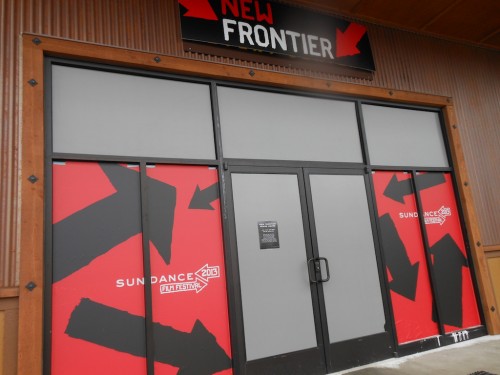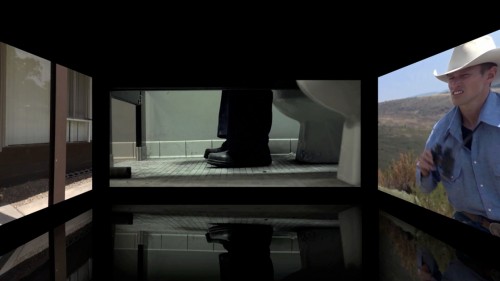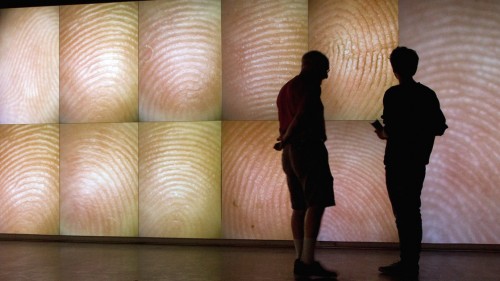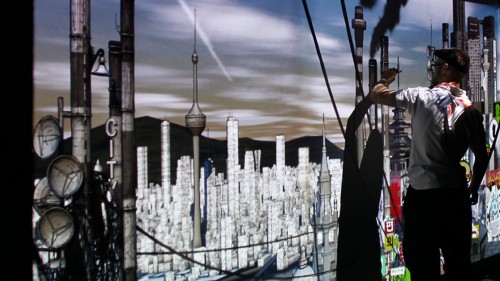
Welcome to the desert of the real: New Frontier at Sundance 2013. Photo: Nettrice Gaskins.
It is the real, and not the map, whose vestiges persist here and there in the deserts that are no longer those of the Empire, but ours. The desert of the real itself. —Jean Baudrillard, 1994
In the film, The Matrix (1999), Morpheus says, “Welcome to the desert of the real” after Neo wakes up from his computer-generated virtual reality. Experiencing the Real as a virtual and natural landscape is one way to conceptualize New Frontier, a Sundance Festival event that is described as a “social and creative space that showcases media installations, multimedia performances, transmedia experiences, panel discussions, and more.” This year’s offerings took place at The Yard in Park City, UT, providing more than 100,000 square feet of multipurpose venue space. In the following excerpt from New Frontier curator Shari Frilot, visitors are welcomed to The Pixelated Pavilion:
The 2013 edition of New Frontier features full-dome wrap-around films, augmented reality experiences, 3-D projection-mapped environments, and datamoshed hip-hop performances. The works by this year’s artists disorient time and space and provoke a reconsideration of how we may integrate the fibers of our bodies with the realities of life on the digital frontier.
Words like “frontier” and “desert” conjure up images of artists as pioneers working on the edge of a border separating two worlds. Indeed, the New Frontier program presents itself as a place of transition where contemporary artists (and filmmakers) blend the virtual and natural (physical) worlds. This is makes sense for a festival like Sundance that showcases independent film.

Meredith Danluck. North of South, West of East,” 2011. Image courtesy of New Frontier and the artist.
Because of my previous coverage of new and evolving ideas and aesthetics in contemporary art such as immersion and augmented reality (AR) art, I was invited to check out New Frontier this year. I interviewed artists and visitors. I participated (as a visitor) by downloading mobile applications to view mobile AR content—applications which extends the experience of lying under a portable dome to watch a cutting-edge film or watching my scanned fingerprint become one of thousands of such images to form a pattern found in nature.

Rafael Lozano-Hemmer. “Pulse Index,” 2013. Image courtesy of New Frontier and the artist.
In a series of special posts for the Art 2.1 column, I will highlight a few New Frontier works, including:
- Pulse Index: Rafael Lozano-Hemmer’s interactive media installation records the heart rates and fingerprints of participants and exhibits them in a beautiful Fibonacci pattern.
- Coral Rekindling Venus: Lynette Wallworth’s mobile augmented-reality and full-dome planetarium presentation designed to nurture (in viewers) an emotional connection between a global audience and the planet’s endangered coral reefs.
- E.m-bed.de/d and Augmented Real: Rap artist Yung Jake’s mobile augmented-reality presentation and Net art performance about tweet culture, datamoshing, hashtags, and memes via Twitter, YouTube, Tumblr, and Instagram, as part of a HTML 5 music video.
- Eyjafjallalokull: A three-dimensional, audio-visual mapping installation that challenges audiences’ perception of space by creating an optical illusion that transforms the walls of New Frontier into a digital display that artistically recreates the seismic event.
- Cityscape 2095: A multi-artist, multimedia presentation that blends painting with light projection to transform the walls of New Frontier into a luminous, three-dimensional cityscape that places spectators on the observatory deck of a skyscraper, where they take in a sprawling, imaginary city as it glitters over the course of one day.

Yannick Jacquet, Mandril, and Thomas Vaquiée. “Cityscape 2095,” (2013). Image courtesy of New Frontier and the artists.
The Matrix was one of the most popular films of the late 1990s in large part because it exposed mainstream audiences to techniques and ideas that they hadn’t seen before. However, the Wachowski brothers got it only partly right. We weave in and out of at least two realities (physical and virtual) in our information-driven society. What they missed in the film was the experience of joining these worlds together—of working within a transitional zone. It is this experimental way of producing art that is explored in New Frontier. Take for example Cityscape 2095 and Eyjafjallalokull by AntiVJ, a visual label created by a group of European artists whose work is focused on the use of projections and how they influence our perceptions of space. In Eyjafjallalokull, Joanie LeMercier creates a mural by drawing directly on the wall with Sharpie marker, then masks out the drawing for the projection.
New Frontier creates openings for contemporary artists to imagine art in the Real. They take chances with techniques that invoke Roman Jakobson’s notion of the dominant, in which technology is the focus component of a work of art:
[I]t rules, determines, and transforms the remaining components. It is the dominant which guarantees the integrity of the structure. —Roman Jakobson, 1960
In my next post, I will explore the possibilities and challenges of mobile Augmented Reality, a fairly new technology that uses tracking via camera-enabled mobile devices like smartphones and iPads to trigger digital overlays—text, images, animations, video or sound—on physical works.




Pingback: Art 2.1 | New Frontier at Sundance 2013: 4D Art and Augmented Real | Art21 Blog
Pingback: Art 2.1 | New Frontier at Sundance 2013: “Pulse Index” and “Coral RKV” | Art21 Blog
Pingback: Art 2.1 | New Frontier at Sundance 2013: The Compilation « SL Art HUD Blog Thingie:
Pingback: 2013: A Year in Review | Renegade Futurism